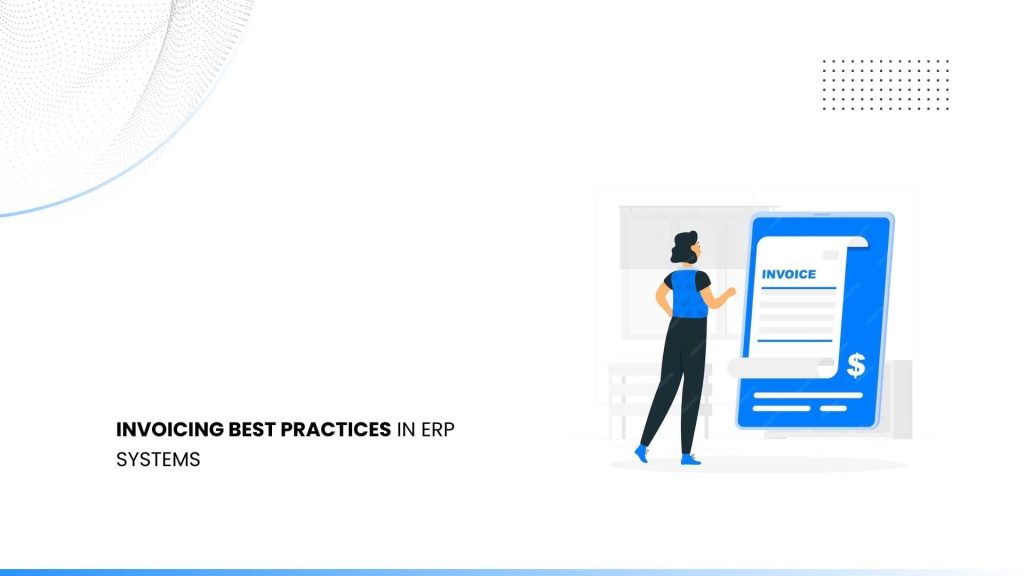Invoicing is the process of billing customers for the goods or services provided. It involves creating an invoice document that includes all the transaction details, such as the description, quantity, and price of the products or services rendered. Invoices usually contain payment terms, such as the due date and accepted payment methods.
In today’s dynamic business landscape, efficient invoicing practices in ERP systems are crucial to driving revenue. Optimizing invoicing within ERP systems improves financial processes, maximizes cash flow, and enhances revenue outcomes.
What is invoice processing?
Invoice processing refers to systematically handling invoices within a business or organization. It involves receiving, reviewing, approving, and paying invoices for goods or services rendered. This process typically includes:
Receipt of Invoices: Invoices are received from suppliers for goods or services provided. This could be in physical or digital format, via mail, email, or electronic data interchange (EDI).
Verification and Approval: Invoices are checked for accuracy, completeness, and policy compliance by matching them with purchase orders and receiving reports.
Approval Workflow: Invoices often need approval from relevant stakeholders or departments before they can be paid. It may involve routing invoices through various levels of authority for authorization.
Data Entry and Recording: Once approved, invoice details are entered into the accounting system for record-keeping and tracking purposes.
Payment: Payments are scheduled based on due dates or payment terms negotiated with vendors. It may involve issuing checks, initiating electronic transfers, or using other payment methods.
Reconciliation: After payment, invoices are reconciled with the corresponding financial transactions to ensure accuracy and completeness.
Best Practices for Invoicing
In today’s fast-paced business environment, efficient invoice processing is required to ensure smooth operations. Here are seven best practices to streamline your invoice processing:
Real-Time Data Integration: Integrate invoice processing with real-time data for accurate financial records and improved decision-making.
Compliance and Accuracy: Adhere to regulatory standards and ensure accuracy in invoice data. Implement robust validation processes to catch discrepancies early, preventing costly errors and compliance issues.
Multiple Payment Options: Offer suppliers diverse payment methods, including electronic transfers, credit cards, and online portals. It enhances flexibility and expedites payment processing, fostering stronger vendor relationships.
Invoice Analytics and Reporting: Leverage analytics tools to gain insights into spending patterns, identify cost-saving opportunities, and optimize cash flow management. Regular reporting enables informed decision-making and strategic planning.
Invoice Tracking and Reminders: Implement a system for tracking invoice status and sending automated reminders for overdue payments. It will improve accountability and lower the risk of late fees.
Centralized and Automated Invoicing: Centralize invoicing processes through automation to streamline workflows and minimize manual intervention. Automation reduces processing time, lowers operational costs, and enhances efficiency.
Customization and Personalization: Tailor invoice processing workflows to suit your organization’s specific needs and preferences. Personalized approaches improve user experience, boost productivity, and foster better stakeholder collaboration.
Conclusion
Acumatica ERP significantly enhances invoice automation by streamlining processes, reducing manual errors, and increasing efficiency. Its robust features, such as automated data extraction and approval workflows, facilitate seamless invoice processing. With Acumatica ERP, businesses can achieve greater accuracy, visibility, and control over their financial operations, which leads to improved productivity and cost savings.
FAQ’s
Q: What is invoicing?
A: Invoice processing manages incoming invoices, involving tasks like data entry, verification, approval, and payment.
Q: Why is invoice processing important?
A: Efficient invoice processing ensures timely vendor payments, maintains supplier relationships, and accurately records businesses’ financial information.
Q: What is invoice automation?
A: Invoice automation refers to using technology, such as software and AI, to streamline and automate the invoice processing workflow. It aims to reduce manual tasks, minimize errors, and improve efficiency.
Q: What are the benefits of invoice automation?
A: Automating invoices improves processing speed, cuts costs, boosts accuracy, ensures compliance with payment terms, and provides better visibility into financial processes.

Vijay comes with a vast experience in ERP and enterprise solutions space with about 20 years of experience in various packaged application like Acumatica, SAP, Orion, Salesforce.com, SugarCRM and, SalesLogix.

